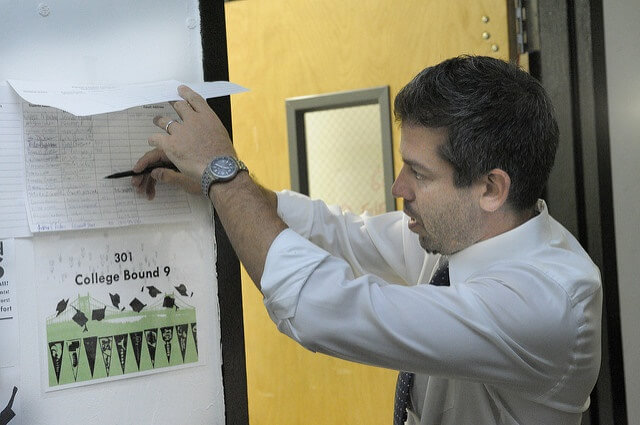 So you’re the proud parent of a high school student. Lucky you! Between the endless hours of carpooling, doing laundry, and constantly asking if your student has their homework done, you’re also aware that these four years are kind of pivotal in your child’s life.
So you’re the proud parent of a high school student. Lucky you! Between the endless hours of carpooling, doing laundry, and constantly asking if your student has their homework done, you’re also aware that these four years are kind of pivotal in your child’s life.
Within the next couple of years, your baby is going to be all grown up and go off into the world to make a name for him or herself (you hope, right?). But how can you make sure they actually leave? College is a pretty good option. First, they actually have to get in though, so here you are, googling ways to make sure your student is successful and has the best application possible.
Standardized test scores are still required for the majority of college applications. While some schools are going test-optional, the trend has yet to take off and be adopted by all schools. Regardless of what schools they’re applying to, your student should probably take the ACT or SAT.
Here are a few tips and tricks on how to get ready for SAT and ACT, help them be successful, and also to make sure they take ownership of preparing for life after high school.
How to Get Ready for SAT and ACT: Make a 4-Year Plan
The spring semester before your student starts high school they will probably create a 4-year plan. This is essentially a breakdown of what classes they think they’ll want to take during their 4 years of high school (hence the name). It is best practice to review these with the school counselor each year before registering for the following year’s classes.
The teachers and school counselor(s) have a lot of students. Yes, they try to get to know each of them as well as possible, but high school is a bit chaotic. So you, as a parent, should try to stay knowledgeable about what classes your student is taking. You know them best after all.
One of the easiest ways to prepare for the ACT or SAT is to take rigorous classes in high school. Make sure they are taking a math and science class every year. The more core content they are exposed to, the better their chances of rocking the ACT and/or SAT.
If your student is planning on applying to highly selective schools, they might have to submit SAT subject test scores. Keep your student’s 4-year plan in the back of your mind as they are talking about career aspirations. Will the classes they take in high school prepare them for college or a career field?
How to Get Ready for SAT and ACT: Draft a Testing Schedule
A great way to make sure your student is set up for success is to come up with some kind of test timeline. Students can start taking the SAT/ACT and AP exams whenever they think they’re ready. There are a lot of freshmen who have AP classes and exams all four years of high school.
These tests all take place at different times. You want to make sure your student isn’t stacking tests. No one wants to take an AP exam, the SAT, and the ACT within a two-month time frame. That sounds like torture. Instead, use their 4-year plan and map out when the best times to take each test is.
Allow for studying. Make time for breaks between tests. You’ll also need to take the class schedule into account so they aren’t studying for an AP exam, but taking the SAT subject test 4 months later (no need to do intense studying twice for the same subject).
Register Early
If your student has test anxiety or is easily distracted, registering early might mean that they get to take the tests at their school. Being in an environment that a student is used to can make a world of difference. In my case, driving to a new place makes me anxious, so if I had to do that before taking a major test I’d be panicked before I even walked through the front door.
If your student’s school isn’t a testing site, registering early will hopefully get them into their preferred testing location. You’ll have time to practice driving (if you’re like me) or at least be able to help them mentally prepare for the change in scenery.
Registering early also means you get a preferred test date. Again, use some kind of timeline so you know when deadlines are, but also where test dates fall in relation to other exams.
Last but not least, registering early means you know exactly how much time your student has to study before their next round of tests. This allows for a bit more flexibility in studying habits. No cramming necessary.
Get to Know the Tests
The more familiar your student is with the different tests and their formats, the greater their chance of success. The ACT has remained relatively the same for quite some time now. But the SAT has been completely revamped. There are new sections, new answer types, and different requirements.
Hint: Make sure your student knows to fill in all of the answer bubbles on BOTH tests. The SAT no longer deducts points for incorrect answers, and the ACT never has.
Studying tips and tricks, in addition to test section breakdowns for both the ACT and SAT.
Provide Prep Tools
There are a plethora of test prep tools out there. Do you need to pay an arm and a leg to get a better score? Probably not.
I have found that there are more free resources for the ACT than there are for the SAT. Do a bit of research. See which tool fits your student’s needs best.
As you can see, all of these kind of fit together. What classes your student chooses to take will affect how well prepared they are for these tests. While you’re working on a 4-year plan, add on when you think they might take the ACT and SAT. Then check out the process. What do the tests look like? What prep tools are available? And most importantly, which is the best fit for your child?
At the end of the day, it’s important to remember that you cannot take the test for them. They still have to sit down and choose the answers. You’re there for support. They’ll need it. You’ve read this, so you’re already doing your part quite well–keep encouraging them.
Give them this list and give them ownership!





